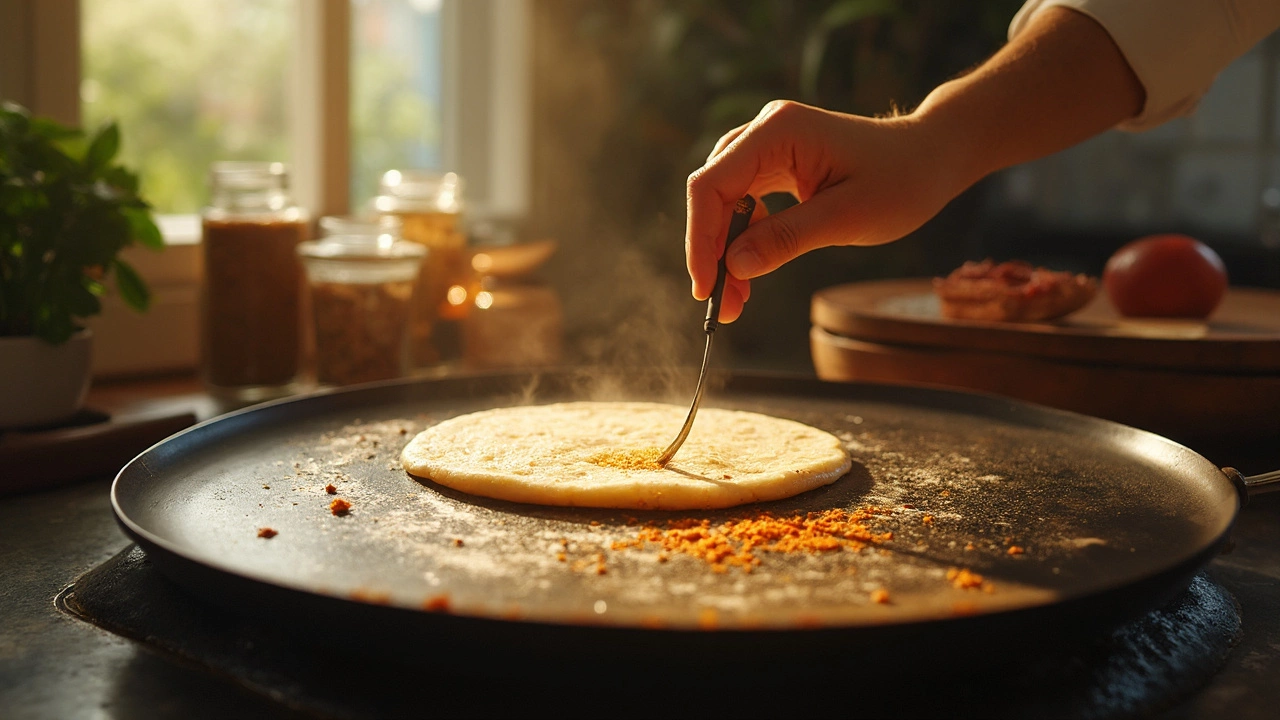Chapati Portion Control: The Ideal Daily Serving for a Healthy Lifestyle
 Mar, 6 2025
Mar, 6 2025
Ever found yourself wondering how many chapatis should you eat in a day to stay healthy? You're not alone. The right portion of chapatis can make a significant difference in your diet, but it all starts with understanding your needs.
First up, let's talk about calories in one roti. It's roughly around 70-80 calories, but don't let those numbers freak you out. It's not just about counting calories; it's about balance. Pair your roti with veggies or a protein, and you've got a complete, satisfying meal.
Now, where does Body Mass Index (BMI) fit into all this? Well, your BMI gives you an idea of your body composition, but it's not the full story. A well-calculated calorie calculator can help tailor your meal portions. It's more about understanding what works best for your body.
- Understanding Calories in One Roti
- The Role of BMI in Portion Control
- Legal Aspects of Food Labeling
- Local Dietary Practices for Chapati Consumption
- Step-by-Step Guide to Calculate Ideal Servings
Understanding Calories in One Roti
Alright, let's get to the nitty-gritty of chapati calorie counting. On average, one plain roti contains about 70-80 calories. But, like most things in life, it's not one-size-fits-all. The calorie count can change based on the ingredients used, especially if you're adding ghee or oil.
Nutritional Breakdown
To get a proper grip on the number, consider this simple breakdown of a standard roti made with whole wheat flour:
- Carbohydrates: 15.7 grams
- Proteins: 3 grams
- Fats: 0.4 grams
And this is just for a basic, no-frills chapati. Add some extras like butter, and you're introducing more calories and fat, so keep that in mind.
Legal Aspects of Food Labeling
When buying packaged roti or any chapati-related products, always glance over the label. Thanks to food labeling laws in many places, knowing the exact calories in one roti should be straightforward. These labels give you the power to choose wisely, focusing on healthier options.
Local Considerations
Locally, the size and type of chapatis you eat in a day can vary greatly. In some regions, chapatis are thinner, while in others, they might be thicker and therefore heavier in calories. Keep this in mind when planning your meals.
| Roti Type | Average Calories |
|---|---|
| Plain Roti | 70-80 |
| Ghee Roti | 100-110 |
| Stuffed Roti | 120-150 |
How to Manage Your Intake
Here's a quick guide to keep your chapati calorie count in check:
- Understand what you're consuming: Take a moment to calculate the calories for the ingredients you're using in your chapati.
- Use a calorie calculator: Several apps and tools online help you enter your specs and get the numbers quick.
- Balance your diet: Pair your chapati with vegetables or lean proteins to create a balanced meal.
At the end of the day, it's about making informed decisions that'll swing you toward a healthier lifestyle. Understanding how many chapatis you eat in a day should not mean deprivation, but smart choices tailored to your personal nutritional needs.
The Role of BMI in Portion Control
Body Mass Index, or BMI, is a crucial tool in the world of nutrition and can be a real game-changer when it comes to maintaining a healthy diet. But how does it tie into chapati serving sizes? Let's break it down.
Your BMI is calculated by dividing your weight in kilograms by the square of your height in meters. It's a quick way to see if you're in a healthy weight range. For adults, a BMI between 18.5 and 24.9 is considered normal. So, how do we use this information to figure out how many chapatis you should be eating?
Calculating Your Chapati Need
Using your BMI, you can personalize your diet:
- First, calculate your BMI using an online calculator or a simple formula. Keep it handy.
- Visit a calorie calculator designed for your particular BMI range. These tools take into account your age, activity level, and nutritional needs.
- Use the calorie results to determine the number of calories you can dedicate to chapatis. Since each roti has about 70-80 calories, you can measure your portions accordingly.
Remember, this isn't about going on a diet. It's more about moderation and making sure you're getting the right nutrients while enjoying your meals. Chapatis are a staple for many, and knowing your limits helps you enjoy them guilt-free.
Legal Guidelines to Consider
While tracking your intake, be aware of local legal guidelines regarding nutritional labeling. Countries often have regulations that foods must meet, especially on calorie content, so make sure you're looking at verified information when calculating the calories in one roti.
For instance, in India, the Food Safety and Standards Authority of India (FSSAI) mandates that packaged foods provide clear labeling on energy and nutrient content. This helps consumers like us make informed decisions. Be sure to check any packaging for nutritional details if you're purchasing pre-made rotis.
By understanding the role of BMI in portion control, you're better equipped to make wise choices that fit your lifestyle without giving up the foods you love. It's as simple as using what you learn from your BMI and applying it to your daily meals.

Legal Aspects of Food Labeling
Alright, ever picked up a pack of chapati flour and wondered what those labels really mean? In India, and many other places, food labeling isn't just for show; there are laws making sure you know exactly what you're eating.
Why Is Labeling Important?
Labels give you the scoop on what you're consuming. From calories in one roti to ingredients and nutritional values, it's all about transparency. The legal standards enforce that brands provide this info so you can make informed choices for your health.
What Goes on a Label?
Thanks to the Food Safety and Standards Authority of India (FSSAI), there’s a bunch of stuff that labels must cover:
- Nutrition Information: This includes the calorie count, important for managing how many chapatis you eat in a day.
- Ingredient List: Helps people avoid allergens or unnecessary additives.
- Manufacturer Details: The who and where of the product, because knowing where it comes from matters.
Steps to Use Food Labels Effectively
- Check the Serving Size: Ensure that you're calculating the calories based on your actual intake.
- Read the Ingredients: Be aware of what goes into your food. Less processed ingredients mean better health.
- Look for Certifications: An FSSAI logo or other certifications indicate compliance.
By staying alert to what you read on labels, you contribute to your daily health goals while understanding local food standards. Plus, it helps manage portions, so you know how many chapatis in a day would be healthy for you.
Local Dietary Practices for Chapati Consumption
When it comes to enjoying chapatis, different regions in India and among various cultural groups have distinct habits and preferences. So, how can we make chapati consumption work for a healthy lifestyle?
Traditional Practices
Traditionally, the art of making chapati is passed down through generations. In many Indian households, chapatis are a staple, often enjoyed with a variety of dishes like dal, sabzi, or a tangy pickle.
Regional Variations
In North India, chapatis are thinner and softer, commonly cooked on a tawa, whereas in South India, they might be thicker and occasionally enriched with ghee. Each style has its unique nutritional perks and taste profile.
Top Tips to Balance Your Chapati Intake
- Start Small: Begin with 1-2 chapatis per meal. Remember, a balanced diet is key. Combine your chapati with fiber-rich salad and a portion of protein, like lentils or lean meats.
- Know Your Portion: Utilize a calorie calculator tailored to your Body Mass Index (BMI). This helps in determining the right number of chapatis in a day without overconsuming.
- Modify Flours: Experiment with different flours like bajra or jowar. These alternatives can increase the nutritional value and keep things interesting.
Legal Labels and What They Mean
Understanding food labels can seem daunting, but knowing what's in your food is crucial. Look for legal standards on packaging that reveal the ingredients and nutritional breakdown, like calories in one roti and fiber content.
Local laws mandate these labels to make it easier for you to maintain a healthy diet. Taking time to read these can support your goal of staying healthy.
Embrace the diversity in chapati-making but keep an eye on portion control. Local dietary choices give you plenty of options to savor chapatis while maintaining a nutritious lifestyle.

Step-by-Step Guide to Calculate Ideal Servings
Nailing the perfect chapati portion can seem tricky, but it's not rocket science. Let’s break it down into easy steps.
1. Know Your Calories
Start by determining how many calories in one roti you're consuming. As mentioned, it's typically around 70-80 calories. This number can vary based on size and ingredients, so check the packaging or a reliable source.
2. Check Your BMI
Before you decide on portions, calculate your Body Mass Index (BMI). Your BMI will help you understand if you're underweight, normal, or overweight, which is crucial for determining your nutritional needs. Tools and apps online make this quick and easy!
3. Calculate Total Daily Calorie Needs
Using a calorie calculator, input your age, weight, height, and activity level. This will give you a daily calorie target. Divide a portion of this total for your chapatis, ensuring you leave room for other nutrients.
4. Portion Your Chapatis Accordingly
Once you have your daily calories figured out, decide how many chapatis should you eat in a day. For someone with moderate activity levels, it might be around 4-5 chapatis, assuming the rest of the diet is balanced. Adjust up or down based on personal goals and nutritional needs.
5. Legal and Local Considerations
Now, why legal aspects? Well, understanding food labeling standards is key. Local guidelines dictate nutrient disclosures, which can help you make informed choices. Also, local dietary habits might inspire you to add some traditional veggies or pulses alongside your chapatis, boosting nutritional value.
Here's a quick example:
| Activity Level | Calories | Chapati Count |
|---|---|---|
| Low | 1800 | 3-4 |
| Moderate | 2200 | 4-5 |
| High | 2600 | 5-6 |
Remember, these are guidelines. Everyone's body reacts differently, so listen to yours and adjust as needed.